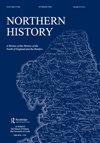DAVID ASQUITH和CHRISTOPHER J.WATSON(编辑),Wakefield Court Roll 1439–40和Accounts 1265–66
IF 0.2
3区 历史学
Q2 HISTORY
引用次数: 0
摘要
韦瑟比最有可能是罗宾的原型,他的罪行是如此臭名昭著,以至于有人专门雇佣了一个团伙来“寻找、带走和斩首罗伯特”(第232页)。诺丁汉的“原始”警长也同样被提议,尤斯塔斯的洛德姆在被任命为约克郡的牧师和随后参与追捕韦瑟比之前曾担任该县的副警长。克鲁克的论点引用了大量的文献资料,尤其是那些来自皇家大法官公署和财政部的资料,这是一本档案研究的杰作,即使是最简短的提及,也能构建一个令人信服的案例。然而,令人沮丧的是,拼图的最后一块不见了,关键法律记录的丢失排除了“对原始不法分子的毫无疑问的识别”(第255页)是韦瑟比的罗伯特。这本文笔优美、内容翔实的专著对于任何对罗宾汉传奇感兴趣的人来说都是必不可少的读物。作者是一位杰出的档案保管员,长期从事中世纪中央政府的记录编目工作,他对胡德的历史来源有着无与伦比的了解,对现有的学术语料库也有透彻的了解。制作精美,索引良好,该卷还包含一些有用的地图和插图。《罗宾汉:传说与现实》对正在进行的关于这个最著名的亡命之徒的起源的学术辩论做出了重要贡献。本文章由计算机程序翻译,如有差异,请以英文原文为准。
DAVID ASQUITH and CHRISTOPHER J. WATSON (eds.), Wakefield Court Roll 1439–40 and Accounts 1265–66
Wetherby was the most likely proto-Robin, his offences being so notorious that a posse had been specially hired ‘to seek, take and behead Robert’ (p. 232). A probable ‘original’ sheriff of Nottingham is similarly proposed, Eustace of Lowdham having previously served as undersheriff of the county before his appointment to the shrievalty of Yorkshire and his subsequent involvement in the manhunt for Wetherby. Crook’s arguments draw upon numerous documentary sources, especially those of the royal chancery and exchequer, a tour de force of archival research that constructs a convincing case from even the briefest of mentions. Yet, frustratingly, the final piece of the jigsaw is missing, the loss of key legal records precluding the ‘unquestionable identification of the original outlaw’ (p. 255) as Robert of Wetherby. This elegantly written and informative monograph is an essential read for anyone interested in the legend of Robin Hood. The author, a distinguished archivist whose long career was spent cataloguing the records of medieval central government, demonstrates both an unrivalled knowledge of the sources for Hood’s historicity and a thorough understanding of the existing corpus of scholarship. Attractively produced and well-indexed, the volume also contains several useful maps and illustrations. Robin Hood: Legend and Reality makes an important contribution to the ongoing scholarly debate on the origins of this most famous of outlaws.
求助全文
通过发布文献求助,成功后即可免费获取论文全文。
去求助
来源期刊

Northern History
Multiple-
CiteScore
0.20
自引率
33.30%
发文量
37
期刊介绍:
Northern History was the first regional historical journal. Produced since 1966 under the auspices of the School of History, University of Leeds, its purpose is to publish scholarly work on the history of the seven historic Northern counties of England: Cheshire, Cumberland, Durham, Lancashire, Northumberland, Westmorland and Yorkshire. Since it was launched it has always been a refereed journal, attracting articles on Northern subjects from historians in many parts of the world.
 求助内容:
求助内容: 应助结果提醒方式:
应助结果提醒方式:


